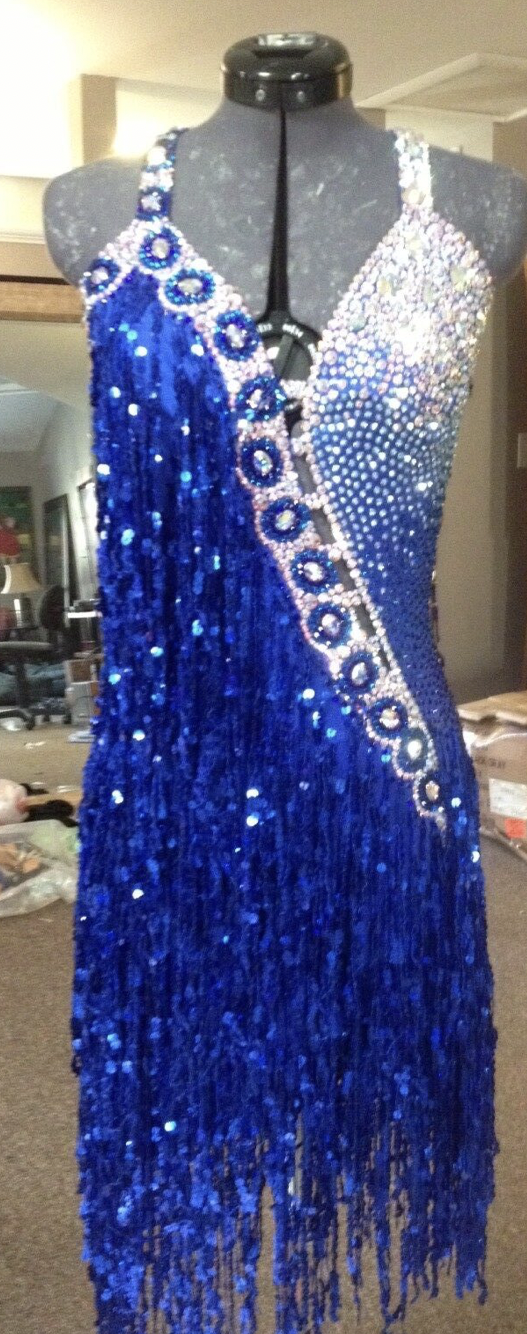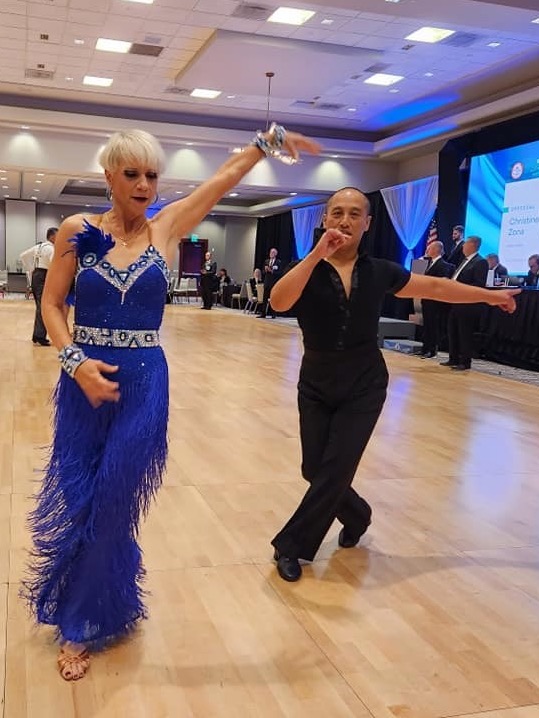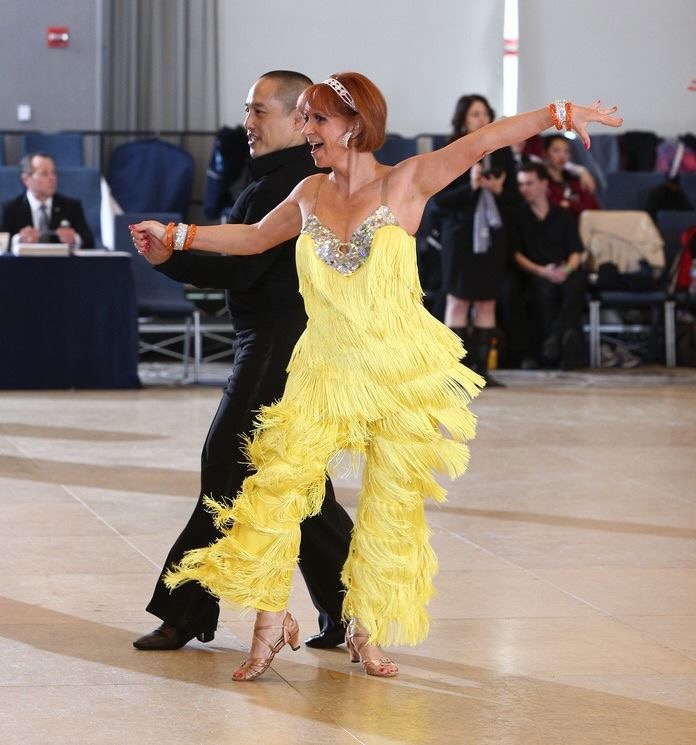I wrote “Say Yes to the Rhythm Dress,” for publication in American Dancer, the official digital magazine of USA Dance, Inc.
In case you’re wondering, USA Dance, Inc. is the governing body of Dancesport in the United States. It is recognized by the United States Olympic and Paralympic Committees (USOPC) and as the U.S. national member federation of the World DanceSport Federation (WDSF), is also recognized by the International Olympic Committee (IOC). Along with the WDSF, USA Dance has the sustaining mission to gain national and global acceptance for DanceSport disciplines as official medal sports in the Olympic Games.
You can read “Say Yes to the Rhythm Dress,” as published by American Dancer in November 2022 or you can scroll down to read it with links to vendors and other resources not allowed by editorial standards of AD. Either way, I hope you enjoy it and I hope it helps you say YES to a dress that’s perfect for you!
Say Yes to the (Rhythm) Dress
Tips for Finding Your Perfect Rhythm (or Latin) Dress
I have a confession. I’m a Dancing with the Stars (DWTS) fan girl. Embarrassing, I know, but I’ve been addicted to the show since its inception back in 2005. I swear, I haven’t missed a single episode in 31 seasons. In fact, it was this very obsession that inspired me to drag my husband to a local ballroom dance studio for lessons, eventually leading to our competitive partnership and my ensuing pathological addiction to shopping for ballroom dance dresses. For the record, I might be the one with the monkey on my back, but the Dancing Doc is definitely the enabler.
Anyway, I got hooked on ballroom dress shopping in 2015 when I said YES to my very first American Rhythm dress. It was a decade after I’d started watching DWTS and in all that time, with all that body action, I’d never witnessed a costume mishap. I remember thinking it was a phenomenon until I started shopping for my own dress and discovered what the average, non-dancing television viewer has no way of knowing. Ballroom dance dresses (at least the good ones) have as much structural reinforcement as modern-day suspension bridges…possibly more. I know wearing fancy dresses gets lots of women hooked, but for me it was the built-in bra and panties. Don’t misunderstand me, I enjoy feeling beautiful as much as the next gal, but I suppose if I had to choose, I prefer the security that comes with vacuum-sealing one’s self into a well-fitting bodysuit. Fortunately, I don’t have to choose and neither do you

Photo and dress design credit: Donna Hamza
My first dress was a Donna, Inc. custom design in bright blue and silver, super sparkly, with really cool hand-sewn sequined fringe and a bodysuit that fit like SPANX shapewear, with a slightly less viselike grip. It really was perfect for me and as if one insanely expensive dress, festooned in more crystals, sequins and fringe than the sum total of all the bedazzled clothing I’d owned in my entire life wasn’t enough, I went and bought another one.
And another one. And another one. To date, I’ve said yes to 31 dresses. It may seem impulsive, but I assure you it is not. While I joke about being a ballroom dress shopaholic, my process, which I’ve been asked to share with American Dancer Magazine, is far from grab-and-go. I am thoughtful and methodical when I embark on finding a new dress and you should be too.

Photo credit: Chicago DanceSport Challenge staff
In case you don’t recognize the byline, I’m the lady who dances Rhythm in fringe pants. I started wearing them in a feeble effort to obscure the frumpy one-inch Cuban heels I was forced wear in order to minimize arthritic hip pain. After bilateral hip replacement, I’m pain-free (yay!), back in big-girl shoes (two-inch flare heels) and eager to show off my improved leg action. This means I am trading my fringe pants for dresses (don’t worry not all of them) and am once again in the market for new ones and since the title of this article caught your eye, chances are, you are too. Luckily, I’m an expert ballroom dress shopper and I’d love to invite you to join me as I explain the things I’ll be considering along the way.
While I don’t dance Latin, it’s worth noting there really is no discernable difference between the two. Rhythm and Latin dresses can be worn interchangeably for either dance style. As you read this article, keep in mind many of the tips are applicable to shopping for all four styles of ballroom dress, with a few pointers specific to Rhythm and Latin.
Let’s begin by addressing the elephant in the room: cost. There is no disputing it. Ballroom dance dresses are expensive. This can make the already overwhelming process of finding one that’s perfect for you even more stressful. Before you get started, it is imperative that you assess at your finances and set a budget. Rhythm and Latin dresses can range in price from several hundred to several thousand dollars, but don’t feel discouraged. There is also a range of purchasing options to explore. I’m confident you’ll find on to fit your budget.
Purchasing a used dress from a consigner or an individual dress owner tends to be less expensive than a buying a brand-new one. Consigners, ready-to-wear retailers and custom design studios often display their inventory on websites, Facebook pages and Instagram so preliminary shopping can be done from the comfort of your sofa. Ballroom dance specific social media groups are a great place for networking with individuals who may be selling their own dresses. I manage Amateur Ballroom Dancers, a private Facebook group dedicated providing resource and serving the needs of amateur ballroom dancers. Dancers frequently post photos of ballroom dresses, shoes, and jewelry they are trying to sell on their own in the group. Sandy Buckholz, owner of Ballroom Bliss consignment shop in Middleburg Heights, OH, posts photos and descriptions of new items that come into her shop several times a week. Spending time online will help you figure out what you like and what you don’t like. I also watch professional finals and WDSF finals on YouTube to see what top dancers are wearing and to discover current dance fashion trends.
Think outside the box and be open to alternative ways of finding your perfect dress too. I have a dear friend, a competitive ballroom dancer (you know who you are), who literally bought a dress right off the back of another competitor. I promise, this is a true story. She saw the woman on the dance floor, fell in love with her dress and approached to ask if she might be interested in selling it. She wasn’t, but the woman let my friend try on her dress after the session ended anyway, decided it looked better on my friend than it did on her and sold it to my friend on the spot! Keep your eyes peeled, because you never know…your next great dress may fall into your lap when you least expect it.
 There are several ways to purchase a new dress. Made-to-measure costumes are crafted to your exact measurements from a vendor’s catalogue of spec patterns and styles. Many of these vendors are in Asia so be sure to send your exact measurements. Asian smalls, mediums and larges run very differently from American sizes. I ordered my first fringe pantsuit – a bright yellow number with rainbow sequins – from a made-to-measure resource called Charismatico, an online retailer specializing in all sorts of stage-wear at extremely competitive price points. My made-to-measure arrived in my mailbox in six weeks. If you go this route, be sure to check the guaranteed production timeline.
There are several ways to purchase a new dress. Made-to-measure costumes are crafted to your exact measurements from a vendor’s catalogue of spec patterns and styles. Many of these vendors are in Asia so be sure to send your exact measurements. Asian smalls, mediums and larges run very differently from American sizes. I ordered my first fringe pantsuit – a bright yellow number with rainbow sequins – from a made-to-measure resource called Charismatico, an online retailer specializing in all sorts of stage-wear at extremely competitive price points. My made-to-measure arrived in my mailbox in six weeks. If you go this route, be sure to check the guaranteed production timeline.
Commissioning a custom-design from a high-end vendor comes with a significantly higher price tag, but you’ll get the ultimate in fit, quality and workmanship. You will be required to pay a deposit to start the custom design process and the balance when the dress is complete, just prior to delivery. The average custom dress takes about four months to complete. On one occasion, I waited a year for a custom dress to be delivered. That’s rare, but if you are in desperate need of a dress, commissioning a custom design may not be for you.
You can also shop for new, ready to wear ballroom dresses straight off the rack. The best place to do this is at dance competitions. Check out the USA Dance Calendar of DanceSport Competitions. Click on the hyperlinks for individual competition websites to find lists of consigners, dress designers and other vendors who will set up booths. Even if you’re not competing, especially at a competition close to home, it’s worth the time and expense to attend. Be sure to bring an empty suitcase. Finally, if you need a dress, but aren’t ready to pull the trigger on purchasing one, consider renting. Most consigners and even some high-end designers offer dresses to rent at affordable prices and some even come with the option to buy.
Once you set your budget, decide which purchasing option is best for you and do a bit of surfing online to figure out what you like and dislike, you’re ready for in-person shopping. Try on lots and lots of dresses. Don’t worry about wasting a sale’s representative’s time. They understand the process and are there to help you. A ballroom dress is a significant investment. It is imperative that you take the time to weigh the main parameters of form, fit and function, also known as The Three F’s, for every dress you consider.
Form is the shape, size, length, silhouette, style, weight, color, fabric, embellishments, slits, cutouts, virtually every visual characteristic of a dress. It is often the first thing you’ll notice and is what initially grabs your attention, kind of like a dress pheromone. It’s safe to assume that everyone on the dancefloor is attempting to attract the judges’ attention so prioritize unique form elements that will help you stand out from the crowd as long as it also flatters your body type. It can be a unique color, interesting stoning pattern, feathers or a high slit if you’ve got a great pair of gams. Rhythm and Latin costumes can be short dresses, pantsuits or two-piece ensembles. A bodysuit is an absolute must, in this style of dress, with built-in bra cups and panties. My advice is to stay away from dresses with nude panties as USA Dance and the WDSF rules governing costuming for women do not permit nude panties.
Fit is the manner in which a dress physically conforms to your body. This includes the structural integrity of the bodysuit. Rhythm and Latin dress styles tend to be fairly revealing, so it is imperative that the built-in panties and bra cups fit properly, provide support and full coverage. To test a dress for fit, try it on and dance. Raise your arms, swing your legs, do a mambo or cha cha basic, twist, turn, bend, squat, move through the same range of motions you would when executing your routines so you can be confident your lady parts will stay put. The last thing a judge (or anyone) wants to see, is you picking panties out of your butt crack when you’re on deck. Trust me, no matter how sly you think you are when fixing a wedgy, it’s never sly enough. Be sure to wear your competition shoes to ensure the length and cut isn’t conducive to your heels getting caught in the hem or some embellishment.
The Just-Because-You-Can-Doesn’t-Mean-You-Should Rule of dress buying is a critical part of assessing both form and fit, particularly in Rhythm and Latin dresses. Low backs, plunging necklines, and cut-outs are common features in Rhythm and Latin dresses, but just because you can wear them, does not mean you should. I do not care if you are at the peak of physical fitness with a rockin’ body, there comes a point in every woman’s life (Senior I and above to be exact) when showing too much skin simply is not a good idea. For the love of Pete, that’s what nude mesh is for. Use it. For the record, this rule also applies to naked legs. Wear fishnets. Period. End of discussion.
The function of a rhythm/Latin dress is to reveal leg lines, amplify hip and body action and show motion. However, perhaps the most important function of any style ballroom dress is to inspire confidence and to make the dancer wearing it feel beautiful. When you feel great in a dress, you dance well.
Sandy Buckholz has dressed hundreds of dancers. The first thing she asks a client who walks into her shop is what she likes and doesn’t like about her body. “It’s a good starting point because say, for example, a woman believes she has great arms, she’ll feel comfortable trying on sleeveless dresses.” This is great advice. If you find yourself becoming paralyzed by indecision, look for styles that accentuate your positive attributes and minimize the negative.
I recently visited ElleDance Studio in Alpharetta, GA to pick up my most recent find: a beautiful and unique black and gold rhythm dress! Yep…I did it again. I said yes to dress number 32. I thought about including a photo, but part of the fun is unveiling a new costume at a competition, so if you want to see it, you’ll just have to catch me dancing at the Gumbo DanceSport Championships in New Orleans, November 25-27, where she (yes, dresses are females) will make her debut.
Anyway, while I was at ElleDance, I had a chance to chat with its founder, Tatiana Noll and one of her up and coming designers, Brittan Eliezer. According to Brittan, who is also a competitive Latin dancer, it’s important to get feedback from clients when helping them find their perfect dress, “In general, we do have guidelines with respect to certain styles for certain body types. However, it’s so specific and so individual because every dress is different and every dancer’s personality is unique. We really apply the guidelines situation by situation. I think the best thing is to trust your dress designer or your stylist, but go with your instinct.”
Tatiana is a seasoned designer with over 16 years of experience in the business. She believes it is also important to pay attention to general fashion trends as they often impact the trends seen on the dance floor. “This can give a dancer and her designer some ideas to implement in creating a custom dress. For example, these days it is fashionable to use boas in Standard dresses, which are also a bit shorter and not as full, but it does not mean that we use trending styles for every customer. The most important, of course, is to find a good balance between what the designer recommends and what a customer likes. In the end, when a dancer steps onto a dance floor, not only should the dress enhance her dancing, but she also should feel beautiful wearing it.”
Shopping for a ballroom dance dress doesn’t have to be overwhelming. Take your time, set a budget, focus on the three Fs and perhaps most importantly, trust your gut. Good luck! See you in the ballroom.
